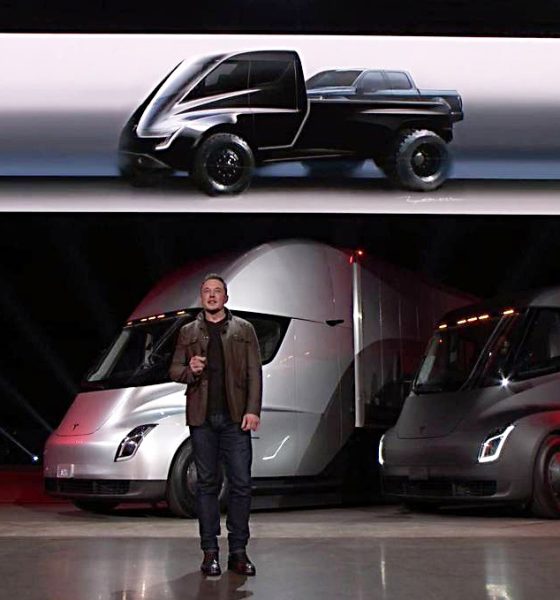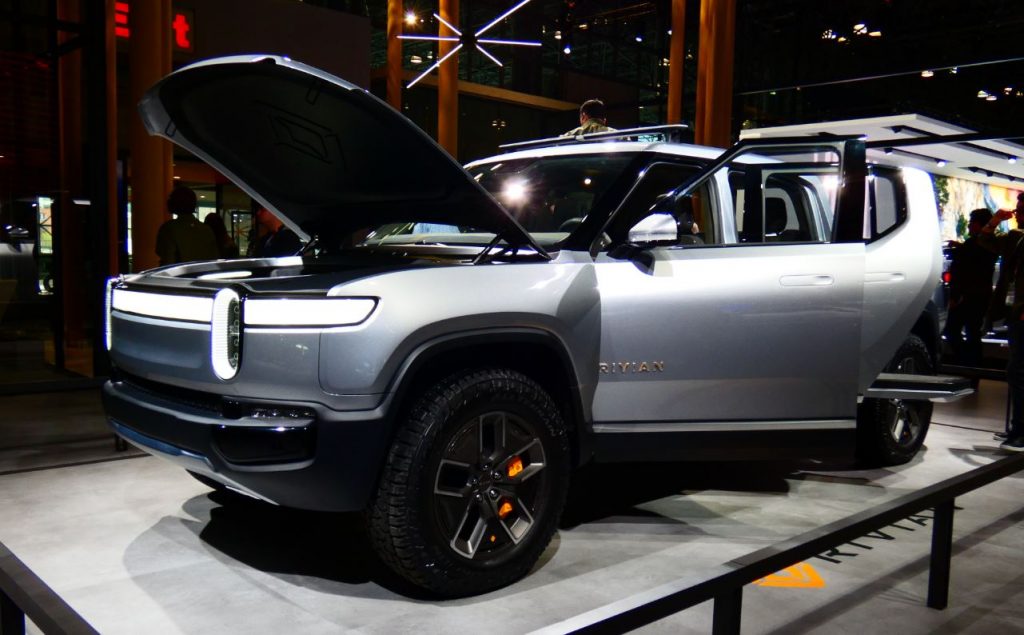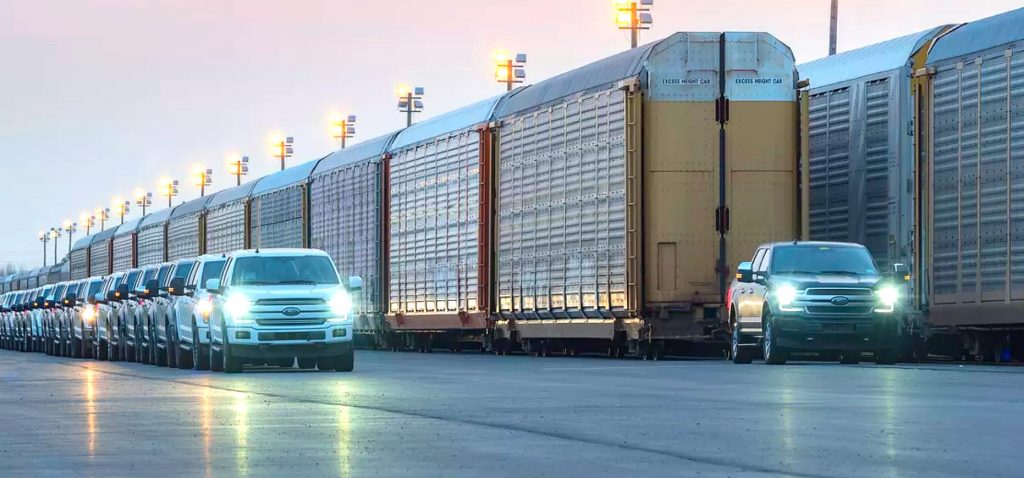

News
Tesla and Rivian are poised to battle Ford and GM for the US’ electric truck market
The US pickup truck market is a hefty prize for any automaker. In the second quarter alone, pickup trucks accounted for 33% of sales from Ford, GM, and Fiat Chrysler, up from 30% the previous year. Full-size trucks, such as the F-150, Silverado and RAM, continue to see growth as well, with the average price of such vehicles hitting $47,255 per unit.
Tyson Jominy, an analyst at research firm J.D. Power, explained in a statement to The Wall Street Journal that the US car industry’s interest in pickup trucks continues to be strong. “Trucks are the one sure bet for all three. They’re trying to take every cent off the table and use it to fund their research and development,” he said.
Yet, just like the passenger car sector, the pickup truck segment is about to feel the disruption from dedicated all-electric vehicles. Elon Musk has announced that Tesla will be releasing its own pickup truck later this year, and that it would be a vehicle so loaded with tech that it would not look out of place in the Blade Runner franchise. Rivian, itself a Detroit-based company, is poised to start producing its R1T pickup truck soon. The R1T is critically acclaimed, being a true off-roader that exudes luxury.

Both Tesla’s pickup truck and Rivian’s R1T will likely enter the market as quickly as their respective automakers are able. The pickup market is ripe for disruption after all, and any company that breaches the segment first with a truck that is both capable and reasonable in price would likely enjoy momentum for years to come. Quite surprisingly, neither Ford nor GM seem to be in any hurry to launch their own pickup trucks to the market.
This is quite surprising considering that both companies have immense experience in truck building. Each company has also stated that it will be releasing its own electric truck. Ford provided a teaser of its F-150 EV last June, which involved an impressive demonstration featuring the truck pulling over a million pounds of cargo. Back in April, GM CEO Mary Barra stated that General Motors will be releasing a “complete range of EVs, including full-size pickups.”
Ford, for its part, stated after its impressive F-150 EV demonstration that the vehicle is not slated for production anytime soon. Ford Chief Product Development Officer Hau Thai-Tang explained in an interview with Yahoo Finance that while a hybrid F-150 will be introduced next year, a battery-electric variant similar to the unit used in the 1-million-pound demonstration is still “a couple years out.” GM is equally vague, if not more. FCA is even less committal, not even confirming its plans for an electric pickup truck.

Considering the coming competition from younger companies such as Tesla and Rivian, both of whom are still hungry and aggressive, Ford, and GM’s decision to adopt a deliberate pace in their EV truck initiatives might prove to be a miscalculation. Such wait-and-see strategies, after all, could easily be remembered in the future as the stuff of hubris, if they are not careful.
This is especially true if one were to look at what the Tesla Truck and the Rivian R1T are both set to offer. Elon Musk has spoken a lot about Tesla’s pickup truck, from its “cyberpunk” appearance, Porsche 911-esque performace, and its $49,000 starting price. Rivian’s R1T, on the other hand, is so steeped in luxury amenities and nifty features that it almost seems like a full suite of Patagonia outdoor gear with wheels.
Granted, both Tesla and Rivian lack the experience in truck-building enjoyed by Ford and GM. That being said, Tesla has extensive experience in developing electric vehicles, and its battery tech is second to none. Rivian, on the other hand, is backed by what could very well be the deepest pocket in the tech industry today: Amazon. With this in mind, veteran automakers might be well advised to expedite the release of their own electric pickups, or risk being outperformed and outmaneuvered by upstart electric vehicle makers that are a fraction of their age.

Elon Musk
Elon Musk’s X will start using a Tesla-like software update strategy
The initiative seems designed to accelerate updates to the social media platform, while maintaining maximum transparency.

Elon Musk’s social media platform X will adopt a Tesla-esque approach to software updates for its algorithm.
The initiative seems designed to accelerate updates to the social media platform, while maintaining maximum transparency.
X’s updates to its updates
As per Musk in a post on X, the social media company will be making a new algorithm to determine what organic and advertising posts are recommended to users. These updates would then be repeated every four weeks.
“We will make the new 𝕏 algorithm, including all code used to determine what organic and advertising posts are recommended to users, open source in 7 days. This will be repeated every 4 weeks, with comprehensive developer notes, to help you understand what changed,” Musk wrote in his post.
The initiative somewhat mirrors Tesla’s over-the-air update model, where vehicle software is regularly refined and pushed to users with detailed release notes. This should allow users to better understand the details of X’s every update and foster a healthy feedback loop for the social media platform.
xAI and X
X, formerly Twitter, has been acquired by Elon Musk’s artificial intelligence startup, xAI last year. Since then, xAI has seen a rapid rise in valuation. Following the company’s the company’s upsized $20 billion Series E funding round, estimates now suggest that xAI is worth tens about $230 to $235 billion. That’s several times larger than Tesla when Elon Musk received his controversial 2018 CEO Performance Award.
As per xAI, the Series E funding round attracted a diverse group of investors, including Valor Equity Partners, Stepstone Group, Fidelity Management & Research Company, Qatar Investment Authority, MGX, and Baron Capital Group, among others. Strategic partners NVIDIA and Cisco Investments also continued support for building the world’s largest GPU clusters.
News
Tesla FSD Supervised wins MotorTrend’s Best Driver Assistance Award
The decision marks a notable reversal for the publication from prior years, with judges citing major real-world improvements that pushed Tesla’s latest FSD software ahead of every competing ADAS system.

Tesla’s Full Self-Driving (Supervised) system has been named the best driver-assistance technology on the market, earning top honors at the 2026 MotorTrend Best Tech Awards.
The decision marks a notable reversal for the publication from prior years, with judges citing major real-world improvements that pushed Tesla’s latest FSD software ahead of every competing ADAS system. And it wasn’t even close.
MotorTrend reverses course
MotorTrend awarded Tesla FSD (Supervised) its 2026 Best Tech Driver Assistance title after extensive testing of the latest v14 software. The publication acknowledged that it had previously criticized earlier versions of FSD for erratic behavior and near-miss incidents, ultimately favoring rivals such as GM’s Super Cruise in earlier evaluations.
According to MotorTrend, the newest iteration of FSD resolved many of those shortcomings. Testers said v14 showed far smoother behavior in complex urban scenarios, including unprotected left turns, traffic circles, emergency vehicles, and dense city streets. While the system still requires constant driver supervision, judges concluded that no other advanced driver-assistance system currently matches its breadth of capability.
Unlike rival systems that rely on combinations of cameras, radar, lidar, and mapped highways, Tesla’s FSD operates using a camera-only approach and is capable of driving on city streets, rural roads, and freeways. MotorTrend stated that pure utility, the ability to handle nearly all road types, ultimately separated FSD from competitors like Ford BlueCruise, GM Super Cruise, and BMW’s Highway Assistant.
High cost and high capability
MotorTrend also addressed FSD’s pricing, which remains significantly higher than rival systems. Tesla currently charges $8,000 for a one-time purchase or $99 per month for a subscription, compared with far lower upfront and subscription costs from other automakers. The publication noted that the premium is justified given FSD’s unmatched scope and continuous software evolution.
Safety remained a central focus of the evaluation. While testers reported collision-free operation over thousands of miles, they noted ongoing concerns around FSD’s configurable driving modes, including options that allow aggressive driving and speeds beyond posted limits. MotorTrend emphasized that, like all Level 2 systems, FSD still depends on a fully attentive human driver at all times.
Despite those caveats, the publication concluded that Tesla’s rapid software progress fundamentally reshaped the competitive landscape. For drivers seeking the most capable hands-on driver-assistance system available today, MotorTrend concluded Tesla FSD (Supervised) now stands alone at the top.
News
Elon Musk’s Grokipedia surges to 5.6M articles, almost 79% of English Wikipedia
The explosive growth marks a major milestone for the AI-powered online encyclopedia, which was launched by Elon Musk’s xAI just months ago.

Elon Musk’s Grokipedia has grown to an impressive 5,615,201 articles as of today, closing in on 79% of the English Wikipedia’s current total of 7,119,376 articles.
The explosive growth marks a major milestone for the AI-powered online encyclopedia, which was launched by Elon Musk’s xAI just months ago. Needless to say, it would only be a matter of time before Grokipedia exceeds English Wikipedia in sheer volume.
Grokipedia’s rapid growth
xAI’s vision for Grokipedia emphasizes neutrality, while Grok’s reasoning capabilities allow for fast drafting and fact-checking. When Elon Musk announced the initiative in late September 2025, he noted that Grokipedia would be an improvement to Wikipedia because it would be designed to avoid bias.
At the time, Musk noted that Grokipedia “is a necessary step towards the xAI goal of understanding the Universe.”
Grokipedia was launched in late October, and while xAI was careful to list it only as Version 0.1 at the time, the online encyclopedia immediately earned praise. Wikipedia co-founder Larry Sanger highlighted the project’s innovative approach, noting how it leverages AI to fill knowledge gaps and enable rapid updates. Netizens also observed how Grokipedia tends to present articles in a more objective manner compared to Wikipedia, which is edited by humans.
Elon Musk’s ambitious plans
With 5,615,201 total articles, Grokipedia has now grown to almost 79% of English Wikipedia’s article base. This is incredibly quick, though Grokipedia remains text-only for now. xAI, for its part, has now updated the online encyclopedia’s iteration to v0.2.
Elon Musk has shared bold ideas for Grokipedia, including sending a record of the entire knowledge base to space as part of xAI’s mission to preserve and expand human understanding. At some point, Musk stated that Grokipedia will be renamed to Encyclopedia Galactica, and it will be sent to the cosmos.
“When Grokipedia is good enough (long way to go), we will change the name to Encyclopedia Galactica. It will be an open source distillation of all knowledge, including audio, images and video. Join xAI to help build the sci-fi version of the Library of Alexandria!” Musk wrote, adding in a later post that “Copies will be etched in stone and sent to the Moon, Mars and beyond. This time, it will not be lost.”








